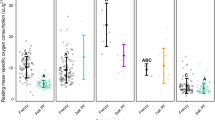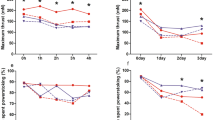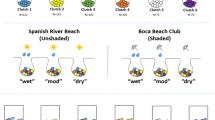Abstract
Incubation conditions are critical in determining numerous traits in reptilian neonates. This is particularly significant in species with low offspring survival such as sea turtle species, because of the extremely high predation rates that hatchlings face during their initial dispersal from nesting beaches. Hatchlings that develop in suboptimal nest environments are likely to be smaller, slower and more susceptible to predation than hatchlings from optimal nest environments. Previous studies have focused on the effects of temperature on hatchling traits, but few have investigated the effects of moisture concentrations, despite moisture levels in nests influencing hatchling size, sex, incubation duration, and hatching success. Here, we incubated eggs of three sea turtle species at various moisture levels and tested the terrestrial and aquatic locomotor performance of the resultant hatchlings during the frenzy and post-frenzy period. We also compared and evaluated the ontogeny of early locomotor performance for each species over the first months of life. Drier incubation conditions produced hatchlings that crawled more slowly and took longer to self-right than hatchlings from wetter incubation conditions. There was no difference in swimming performance associated with moisture treatments. We suggest that moisture in the nest environment during incubation may influence hatchling performance via their initial hydration levels. Thus, nest moisture influences terrestrial performance (i.e., escaping from the nest and dispersing across the beach), although upon entering the ocean hatchlings have the opportunity to rehydrate by drinking and thus, differences in locomotor performance associated with moisture treatments cease.



Similar content being viewed by others
Data availability
Data will be made available from the authors upon request.
References
Ackerman RA, Lutz P, Musick J (1997) The nest environment and the embryonic development of sea turtles. In: Lutz PL, Musick J (eds) The biology of sea turtles, vol 1. CRC Press, Boca Raton, Florida, pp 83–106
Ackerman RA, Seagrave RC, Dmi'el R, Ar A (1985) Water and heat exchange between parchment-shelled reptile eggs and their surroundings. Copeia 3:703–711
Bates D (2007) Linear mixed model implementation in lme4. University of Wisconsin, vol 15 (Unpublished manuscript)
Bennett JM, Taplin LE, Grigg GC (1986) Sea water drinking as a homeostatic response to dehydration in hatchling loggerhead turtles Caretta caretta. Comp Biochem Physiol A Physiol 83(3):507–513
Blackburn DG (1999) Viviparity and oviparity: evolution and reproductive strategies. Encyclopedia of reproduction, vol 3. Academic Press, San Diego, California, pp 994–1003
Bolten AB (2003) Variation in sea turtle life history patterns: neritic vs. oceanic developmental stages. Biol Sea Turtles 2:243–257
Booth D (1998) Incubation of turtle eggs at different temperatures: do embryos compensate for temperature during development? Physiol Biochem Zool 71(1):23–26
Booth D (2006) Influence of incubation temperature on hatchling phenotype in reptiles. Physiol Biochem Zool 79(2):274–281
Booth D (2009) Swimming for your life: locomotor effort and oxygen consumption during the green turtle (Chelonia mydas) hatchling frenzy. J Exp Biol 212(1):50–55
Booth D (2014) Kinematics of swimming and thrust production during powerstroking bouts of the swim frenzy in green turtle hatchlings. Biol Open 3(10):887–894
Booth D (2017) The influence of incubation temperature on sea turtle hatchling quality. Integr Zool 12(5):352–360
Booth D, Evans A (2011) Warm water and cool nests are best. How global warming might influence hatchling green turtle swimming performance. PLoS ONE 6(8):e23162
Bouchard SS, Bjorndal KA (2000) Sea turtles as biological transporters of nutrients and energy from marine to terrestrial ecosystems. Ecology 81(8):2305–2313
Burgess EA, Booth DT, Lanyon JM (2006) Swimming performance of hatchling green turtles is affected by incubation temperature. Coral Reefs 25(3):341–349
Cagle K, Packard G, Miller K, Packard M (1993) Effects of the microclimate in natural nests on development of embryonic painted turtles, Chrysemys picta. Funct Ecol 7:653–660
Carr AF, Ogren LH (1960) The ecology and migrations of sea turtles, IV: the green turtle in the Caribbean Sea. Bulletin of the AMNH 121:1–48
Caut S, Guirlet E, Girondot M (2010) Effect of tidal overwash on the embryonic development of leatherback turtles in French Guiana. Mar Environ Res 69(4):254–261
Cavallo C, Dempster T, Kearney MR, Kelly E, Booth D, Hadden KM, Jessop TS (2015) Predicting climate warming effects on green turtle hatchling viability and dispersal performance. FunctEcol 29(6):768–778
Chen H-C, Cheng I, Hong E (2007) The influence of the beach environment on the digging success and nest site distribution of the green turtle, Chelonia mydas, on Wan-an Island, Penghu Archipelago, Taiwan. J Coast Res 23(5(235)):1277–1286
Chung F, Pilcher N, Salmon M, Wyneken J (2009a) Offshore migratory activity of hawksbill turtle (Eretmochelys imbricata) hatchlings, I. Quantitative analysis of activity, with comparisons to green turtles (Chelonia mydas). Chelonian Conserv Biol 8(1):28–34
Chung F, Pilcher N, Salmon M, Wyneken J (2009b) Offshore migratory activity of hawksbill turtle (Eretmochelys imbricata) hatchlings, II. Swimming gaits, swimming speed, and morphological comparisons. Chelonian Conserv Biol 8(1):35–42
Dornfeld TC, Robinson NJ, Tomillo PS, Paladino FV (2015) Ecology of solitary nesting olive ridley sea turtles at Playa Grande, Costa Rica. Mar Biol 162(1):123–139
Finkler MS (1999) Influence of water availability during incubation on hatchling size, body composition, desiccation tolerance, and terrestrial locomotor performance in the snapping turtle Chelydra serpentina. Physiol Biochem Zool 72(6):714–722
Foley RE, Spotila JR (1978) Effect of wind speed, air temperature, body size and vapor density difference on evaporative water loss from the turtle Chrysemys scripta. Copeia 4:627–634
Foley AM, Peck SA, Harman GR (2006) Effects of sand characteristics and inundation on the hatching success of loggerhead sea turtle (Caretta caretta) clutches on low-relief mangrove islands in southwest Florida. Chelonian Conserv Biol 5(1):32–41
Fuentes M, Hamann M, Limpus C (2010a) Past, current and future thermal profiles of green turtle nesting grounds: implications from climate change. J Exp Mar Biol Ecol 383(1):56–64
Fuentes MMB, Limpus CJ, Hamann M, Dawson J (2010b) Potential impacts of projected sea-level rise on sea turtle rookeries. AquatConserv Mar FreshwEcosyst 20(2):132–139
Gatto CR, Reina RD (2020) The ontogeny of sea turtle hatchling swimming performance. Biol J Linn Soc 131(1):172–182
Godfrey MH, Mrosovsky N (2006) Pivotal temperature for green sea turtles, Chelonia mydas, nesting in Suriname. Herpetol J 16(1):55–61
Godley B, Broderick A, Glen F, Hays G (2002) Temperature-dependent sex determination of Ascension Island green turtles. Mar Ecol Prog Ser 226:115–124
Gyuris E (1994) The rate of predation by fishes on hatchlings of the green turtle (Chelonia mydas). Coral Reefs 13(3):137–144
Hays GC, Mackay A, Adams C, Mortimer J, Speakman J, Boerema M (1995) Nest site selection by sea turtles. J Mar Biol Assoc UK 75(3):667–674
Hertz PE (1980) Responses to dehydration in Anolis lizards sampled along altitudinal transects. Copeia 1980:440–446
Hewavisenthi S, Parmenter CJ, Gatten, Jr R (2001) Influence of incubation environment on the development of the flatback turtle (Natator depressus). Copeia 3:668–682
Higgins BM (2003) Sea turtle husbandry, vol 2. The biology of sea turtles. CRC Press, Boca Raton, pp 411–440
Hill JE, Paladino FV, Spotila JR, Tomillo PS (2015) Shading and watering as a tool to mitigate the impacts of climate change in sea turtle nests. PLoS ONE 10(6):e0129528
Howard R, Bell I, Pike DA (2014) Thermal tolerances of sea turtle embryos: current understanding and future directions. Endang Species Res 26(1):75–86
IPCC (2014) Climate change 2014: synthesis report. In: Core Writing Team, Pachauri RK, Meyer LA (eds) Contribution of working groups I, II and III to the fifth assessment report of the intergovernmental panel on climate change. IPCC, Geneva, Switzerland, p 151
Karavas N, Georghiou K, Arianoutsou M, Dimopoulos D (2005) Vegetation and sand characteristics influencing nesting activity of Caretta caretta on Sekania beach. Biol Conserv 121(2):177–188
Kraemer JE, Bell R (1980) Rain-induced mortality of eggs and hatchlings of loggerhead sea turtles (Caretta caretta) on the Georgia coast. Herpetologica 36(1):72–77
Lamont MM, Fujisaki I (2014) Effects of ocean temperature on nesting phenology and fecundity of the loggerhead sea turtle (Caretta caretta). J Herpetol 48(1):98–102
Limpus CJ (2008) A biological review of Australian marine turtles. In: The state of queensland, environmental protection agency, vol 1. Queensland Government, Brisbane, Queensland
Lolavar A, Wyneken J (2015) Effect of rainfall on loggerhead turtle nest temperatures, sand temperatures and hatchling sex. Endang Species Res 28(3):235–247
Lolavar A, Wyneken J (2017) Experimental assessment of the effects of moisture on loggerhead sea turtle hatchling sex ratios. Zoology 123:64–70
Mazaris AD, Kallimanis AS, Pantis JD, Hays GC (2013) Phenological response of sea turtles to environmental variation across a species' northern range. Proc R SocLond B Biol Sci 280(1751):20122397
McGehee MA (1990) Effects of moisture on eggs and hatchlings of loggerhead sea turtles (Caretta caretta). Herpetologica 46(3):251–258
McQueen A, Naimo AC, Teunissen N, Magrath RD, Delhey K, Peters A (2017) Bright birds are cautious: seasonally conspicuous plumage prompts risk avoidance by male superb fairy-wrens. Proc R SocLond B Biol Sci 284(1857):20170446
Miller K, Packard GC, Packard MJ (1987) Hydric conditions during incubation influence locomotor performance of hatchling snapping turtles. J Exp Biol 127(1):401–412
Nakagawa S, Cuthill IC (2007) Effect size, confidence interval and statistical significance: a practical guide for biologists. Biol Rev 82(4):591–605
Patino-Martinez J, Marco A, Quiñones L, Hawkes LA (2014) The potential future influence of sea level rise on leatherback turtle nests. J Exp Mar Biol Ecol 461:116–123
Pereira CM, Booth DT, Limpus CJ (2012) Swimming performance and metabolic rate of flatbackNatator depressus and loggerhead Caretta caretta sea turtle hatchlings during the swimming frenzy. Endang Species Res 17(1):43–51
Phillott AD, Parmenter CJ (2006) The ultrastructure of sea turtle eggshell does not contribute to interspecies variation in fungal invasion of the egg. Can J Zool 84(9):1339–1344
Plotkin PT (2007) Biology and conservation of ridley sea turtles. JHU Press, Baltimore
R Core Team (2014) R: A language and environment for statistical computing. Vienna, Austria: R Foundation for Statistical Computing; 2014.
Rafferty AR, Evans RG, Scheelings TF, Reina RD (2013) Limited oxygen availability in utero may constrain the evolution of live-birth in reptiles. Am Nat 181(2):245–253
Ragotzkie RA (1959) Mortality of loggerhead turtle eggs from excessive rainfall. Ecology 40(2):303–305
Reina R (2000) Salt gland blood flow in the hatchling green turtle, Chelonia mydas. J Comp Physiol B 170(8):573–580
Reina RD, Jones TT, Spotila JR (2002) Salt and water regulation by the leatherback sea turtle Dermochelys coriacea. J Exp Biol 205(13):1853–1860
Rings CC, Rafferty AR, Guinea ML, Reina RD (2014) The impact of extended preovipositional arrest on embryonic development and hatchling fitness in the flatback sea turtle. Physiol Biochem Zool 88(2):116–127
Rusli MU, Booth DT, Joseph J (2016) Synchronous activity lowers the energetic cost of nest escape for sea turtle hatchlings. J Exp Biol 219(10):1505–1513
Salmon M, Hamann M, Wyneken J, Schauble C (2009) Early swimming activity of hatchling flatback sea turtles Natator depressus: a test of the ‘predation risk’hypothesis. Endang Species Res 9(1):41–47
Stubbs JL, Kearney MR, Whiting SD, Mitchell NJ (2014) Models of primary sex ratios at a major flatback turtle rookery show an anomalous masculinising trend. Clim Change Responses 1(1):1
van de Merwe J, Ibrahim K, Whittier J (2006) Effects of nest depth, shading, and metabolic heating on nest temperatures in sea turtle hatcheries. Chelonian Conserv Biol 5(2):210–215. https://doi.org/10.2744/1071-8443(2006)5[210:EONDSA]2.0.CO;2
Viechtbauer W (2010) Conducting meta-analyses in R with the metafor package. J Stat Softw 36(3):1–48
Whelan CL, Wyneken J (2007) Estimating predation levels and site-specific survival of hatchling loggerhead seaturtles (Caretta caretta) from south Florida beaches. Copeia 3:745–754
Whelan CL (2007) Estimating predation levels and site-specific survival of hatchling loggerhead seaturtles (Caretta caretta) from South Florida beaches. Copeia 3:745–754
Williamson SA, Evans RG, Reina RD (2017a) Use of hypoxia to extend embryonic arrest in turtle eggs and prevent movement-induced mortality. Biol Cons 216:86–92. https://doi.org/10.1016/j.biocon.2017.10.009
Williamson SA, Evans RG, Robinson NJ, Reina RD (2017b) Hypoxia as a novel method for preventing movement-induced mortality during translocation of turtle eggs. Biol Conserv 216:86–92
Wood DW, Bjorndal KA (2000) Ross S (2000) Relation of temperature, moisture, salinity, and slope to nest site selection in loggerhead sea turtles. Copeia 1:119–119
Wood A, Booth DT, Limpus CJ (2014) Sun exposure, nest temperature and loggerhead turtle hatchlings: Implications for beach shading management strategies at sea turtle rookeries. J Exp Mar Biol Ecol 451:105–114
Wyneken J (1997) Sea turtle locomotion: mechanisms, behavior, and energetics. In: Lutz PL, Musick J (eds) The Biology of Sea Turtles, vol 1. CRC Press, Boca Raton, Florida, pp 165–198
Wyneken J, Lolavar A (2015) Loggerhead sea turtle environmental sex determination: implications of moisture and temperature for climate change based predictions for species survival. J Exp Zool Part B Mol Dev Evol 324(3):295–314
Wyneken J, Salmon M (1992) Frenzy and postfrenzy swimming activity in loggerhead, green, and leatherback hatchling sea turtles. Copeia 2:478–484
Acknowledgements
We thank everyone at the Heron Island research station, the Curtis Island flatback research team and James and the Tiwi Land Council for their help collecting eggs and releasing turtles. Thanks to Jan, Rod and Neal from Aquacore for all of their help housing the turtles and to Fran, Vanessa and Jade for their help measuring and caring for the turtles. Thanks to Jeanette Wyneken, Amanda Southwood Williard, Stephen Dunbar and two anonymous reviewers for their insightful and useful comments on a draft of this manuscript. Thanks to the Herpetological Conservation International Michael Dee grant, the Australian Wildlife Society University Student grant, the Great Barrier Reef Marine Park Authority Reef Guardians grant and the Monash University School of Biological Sciences for their financial support. CG was also supported by an Australian Government Research Training Program (RTP) scholarship.
Funding
CG was supported by the Herpetological Conservation International Michael Dee grant, the Australian Wildlife Society University Student grant, the Great Barrier Reef Marine Park Authority Reef Guardians grant and the Monash University School of Biological Sciences. CG was also supported by an Australian Government Research Training Program (RTP) scholarship.
Author information
Authors and Affiliations
Contributions
CG and RR developed the experimental design. CG conducted the experiment and performed the statistical analysis. CG and RR discussed the results and contributed to final manuscript.
Corresponding author
Ethics declarations
Conflict of interest
The authors declare no competing interests.
Ethical approval
Eggs were collected under Queensland scientific purposes permit WITK17747816 (Chelonia mydas) and WITK18685417 (Natator depressus) and Northern Territory permit to take wildlife 62703 (Lepidochelys olivacea). Hatchlings were housed and tested under research permit 10008208 and all procedures were approved by the Monash University Biological Sciences Animal Ethics Committee (BSCI/2016/23).
Additional information
Communicated by Philip Withers.
Publisher's Note
Springer Nature remains neutral with regard to jurisdictional claims in published maps and institutional affiliations.
Electronic supplementary material
Below is the link to the electronic supplementary material.
Rights and permissions
About this article
Cite this article
Gatto, C.R., Reina, R.D. Sea turtle hatchling locomotor performance: incubation moisture effects, ontogeny and species-specific patterns. J Comp Physiol B 190, 779–793 (2020). https://doi.org/10.1007/s00360-020-01307-z
Received:
Revised:
Accepted:
Published:
Issue Date:
DOI: https://doi.org/10.1007/s00360-020-01307-z




